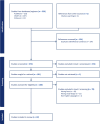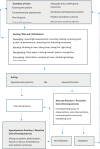When Nurses Worry: A Concept Analysis of Intuition in Clinical Deterioration
- PMID: 40211551
- PMCID: PMC12271650
- DOI: 10.1111/jan.16956
When Nurses Worry: A Concept Analysis of Intuition in Clinical Deterioration
Abstract
Background: Nurse worry is a criterion often included in early warning systems tools and used to escalate care when other clinical markers do not indicate deterioration. What it means to worry, however, is not always clear.
Aims: To generate a concept analysis of nurse worry in relation to clinical deterioration.
Design: Rodgers's evolutionary method was used.
Method: A review was first conducted in April 2024, searching the Cumulative Index for Nursing and Allied Health Literature, Pubmed, EmCare, and Embase databases. A total of 22 articles were subjected to analysis of the antecedents, attributes, and consequences of nurse worry in the context of clinical deterioration. The processes of nurse worry were subsequently mapped and conceptualised, leading to a descriptive statement of nurse worry.
Results: Worry captures a nurse's sense of knowing the patient and is embodied via assessing, sensing, recognising, and processing information, cues, and patterns.
Conclusion: Nurse worry is a complex process, impacted by external and internal factors. Implications for the profession or patient care: Assured practice, driven by validation of a nurse's worry, leads to proactive care of the deteriorating patient, whereas apprehensive practice, driven by fear and trepidation, leads to reactive care of the deteriorating patient.
Impact: Nurse worry is a criterion often included in early warning systems tools and used to escalate care when other clinical markers do not indicate clinical deterioration. What it means to worry, however, is not always clear. From the concept analysis, a descriptive statement of nurse worry emerged. Worry captures a nurse's sense of knowing the patient and is embodied via assessing, sensing, recognising, and processing information, cues, and patterns.
Implications for the profession or patient care: This research has implications for nurses, policymakers, and organisations, as nurse worry is an important element in detecting clinical deterioration. Nurse worry must be organisationally supported.
Reporting methods: PRISMA Extension for Scoping Reviews (PRISMA-SCR).
Patient or public contribution: No Patient or Public Contribution.
Keywords: clinical deterioration; concept analysis; escalation; nurse worry.
© 2025 The Author(s). Journal of Advanced Nursing published by John Wiley & Sons Ltd.
Conflict of interest statement
The authors declare no conflicts of interest.
Figures
Similar articles
-
Experiences of registered nurses as managers and leaders in residential aged care facilities: a systematic review.Int J Evid Based Healthc. 2011 Dec;9(4):388-402. doi: 10.1111/j.1744-1609.2011.00239.x. Int J Evid Based Healthc. 2011. PMID: 22093388
-
Consequences, costs and cost-effectiveness of workforce configurations in English acute hospitals.Health Soc Care Deliv Res. 2025 Jul;13(25):1-107. doi: 10.3310/ZBAR9152. Health Soc Care Deliv Res. 2025. PMID: 40622683
-
Nurses as substitutes for doctors in primary care.Cochrane Database Syst Rev. 2018 Jul 16;7(7):CD001271. doi: 10.1002/14651858.CD001271.pub3. Cochrane Database Syst Rev. 2018. PMID: 30011347 Free PMC article.
-
What is the value of routinely testing full blood count, electrolytes and urea, and pulmonary function tests before elective surgery in patients with no apparent clinical indication and in subgroups of patients with common comorbidities: a systematic review of the clinical and cost-effective literature.Health Technol Assess. 2012 Dec;16(50):i-xvi, 1-159. doi: 10.3310/hta16500. Health Technol Assess. 2012. PMID: 23302507 Free PMC article.
-
Do Magnet®-accredited hospitals show improvements in nurse and patient outcomes compared to non-Magnet hospitals: a systematic review.JBI Database System Rev Implement Rep. 2015 Jul 17;13(6):168-219. doi: 10.11124/jbisrir-2015-2262. JBI Database System Rev Implement Rep. 2015. PMID: 26455752
References
-
- Australian Institute of Health and Wellbeing . 2024. “Rural and Remote Health.” https://www.aihw.gov.au/reports/rural‐remote‐australians/rural‐and‐remot....
Publication types
MeSH terms
LinkOut - more resources
Full Text Sources
Medical
Miscellaneous




